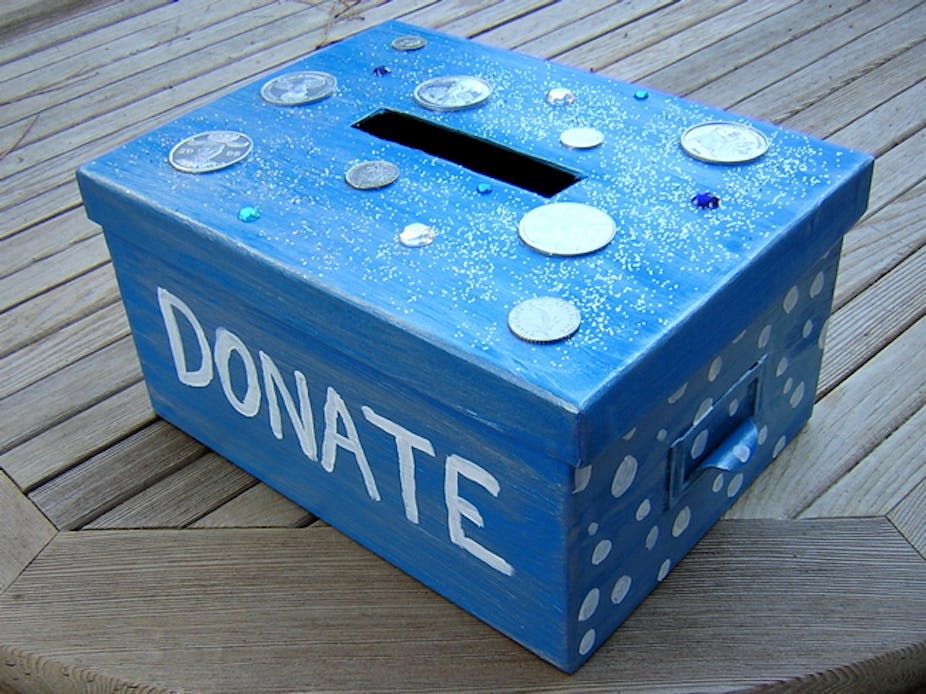The release of political donation data from 2011—2012 has predictably generated headlines about who paid what to which Australian political parties over the past year.
In line with the Commonwealth Electoral Act 1918, all registered political parties are required to report cash and certain in-kind donations worth more than $12,100. This requirement is meant to facilitate public scrutiny by letting us see exactly which gun manufacturers, pharmaceutical companies, casinos and wealthy eccentrics such as Clive Palmer through his company Minerology are funding our democracy.
But as critics have regularly noted, the fact there can be up to a year-long delay between funds being donated and the parties reporting them means we are only able to apply that scrutiny from a distance.
Even worse, a business or individual is actually able to donate up to $96,000 without this becoming public knowledge, thanks to a loophole which classifies donations to each branch of a national political party as separate events. These gaps in disclosure requirements are obviously concerning, so much so that the federal government is currently trying to pass a range of amendments that will make the system more transparent.
But for all this focus on who is giving to our political parties, there is a worrying lack of interest in what these parties do with the money we give them: the public funding that all parties earning more than 4% of the vote at a federal election get from the Australian Electoral Commission.
Following the 2010 poll, public funding for Australian political parties totalled more than $53 million, yet we have no way of knowing how a single cent of that money was spent.
You read that right: we generously gave the Australian Labor Party and the Liberal Party around $21 million dollars each, along with more than $7 million for the Australian Greens, $2.4 million for the Nationals and even $10,000 for the Shooters and Fishers Party to help pay for their election campaigns.
And what sort of accounting did we get in return? Absolutely none.
Australia is one of the only countries in the democratic world that does not require political parties to report electoral expenditure – how much they spend trying to earn our votes, or where and when they spend it. The USA, Canada, Germany, France, the United Kingdom, even our friends across the ditch in New Zealand, all require their parties to report both donations and expenditure, even where this expenditure is done with privately-raised money.
This two-pronged approach is beneficial because it makes the act of campaigning more transparent. If you were keen to understand your favourite candidate’s media-buying strategy, or identify the seats that the national parties really care about, you’d be able to do that in most other countries just by looking at where they’ve spent their money.
By contrast, there is simply no way to track campaigning in Australia, other than laboriously piecing together the parties’ activities through media coverage and the materials they distribute (a conceptual jigsaw which forms the basis of my own doctoral research).
Now, I’m not suggesting that parties should necessarily account for every cent they spend, as preparing and processing this paperwork would be a significant burden for minor parties and the AEC alike. But there are still things that our parties could be required to do to make their spending more transparent.
For one, they could be required to disclose the total cost of their campaign activities as a condition of receiving public funds. They could also be required to provide some form of spending map which shows, in percentage or dollar terms, how much of their campaign budget was spent in each electorate. My own interviews with campaign staff suggest that parties are acutely aware of the budget for each individual seat campaign, so the figures needed to meet such a requirement almost certainly already exist on a spreadsheet somewhere in each party HQ.
Finally, parties could be required to identify the companies that they contract with to carry out campaign work such as printing, advertising, market research and media buying. This last requirement would help make government procurement more transparent in the long run, as we would then be able to track relationships between parties and commercial suppliers to ensure old campaign mates aren’t later rewarded with lucrative government contracts.
These simple changes have not been introduced in Australia because they’d be a pain in the neck — not to mention a potential source of embarrassment — for the political parties which ultimately become governments.
But with millions of dollars of public funding on the table for this year’s federal election, isn’t it about time we demanded they put themselves out just a little bit?

